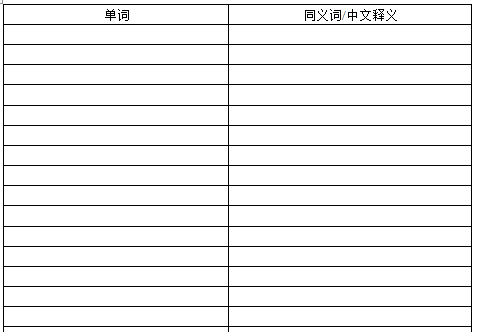摘要:新托福阅读能力是考试主办方重点考察的方向之一。除了在托福阅读部分考察外,在其他单项中也会出题考察。因此这需要考生们学习更多实用技巧来应对考试的挑战,大家在平时一定要多加练习,在下文中小编整理了托福阅读常考话题:苏美尔和埃及,一起来看看吧!
Passage 5:
Crafts in the Ancient Middle East
Some of the earliest human civilizations arose in southern Mesopotamia, in what is now southern Iraq, in the fourth millennium B.C.E. In the second half of the millennium, in the south around the city of Uruk, there was an enormous escalation in the area occupied by permanent settlements. A large part of that increase took place in Uruk itself, which became a real urban center surrounded by a set of secondary settlements. While population estimates are notoriously unreliable, scholars assume that Uruk inhabitants were able to support themselves from the agricultural production of the field surrounding the city, which could be reached with a daily commute. But Uruk’s dominant size in the entire region, far surpassing that of other settlements, indicates that it was a regional center and a true city. Indeed, it was the first city in human history.
The vast majority of its population remained active in agriculture, even those people living within the city itself. But a small segment of the urban society started to specialize in nonagricultural tasks as a result of the city’s role as a regional center. Within the productive sector, there was a growth of a variety of specialist craftspeople. Early in the Uruk period, the use of undecorated utilitarian pottery was probably the result of specialized mass production. In an early fourth-millennium level of the Eanna archaeological site at Uruk, a pottery style appears that is most characteristic of this process, the so-called beveled-rim bowl. It is a rather shallow bowl that was crudely made in a mold; hence, in only a limited number of standard sizes. For some unknown reason, many were discarded, often still intact, and thousands have been found all over the Near East. The beveled-rim bowl is one of the most telling diagnostic finds for identifying an Uruk-period site. Of importance is the fact that it was produced rapidly in large amounts, most likely by specialists in a central location.
A variety of documentation indicates that certain goods, once made by a family member as one of many duties, were later made by skilled artisans. Certain images depict groups of people, most likely women, involved in weaving textiles, an activity we know from later third-millennium texts to have been vital in the economy and to have been centrally administered. Also, a specialized metal-producing workshop may have been excavated in a small area at Uruk. It contained a number of channels lined by a sequence of holes, about 50 centimeters deep, all showing burn marks and filled with ashes. This has been interpreted as the remains of a workshop where molten metal was scooped up from the channel and poured into molds in the holes. Some type of mass production by specialists were involved here.
Objects themselves suggest that they were the work of skilled professionals. In the late Uruk period(3500-3100 B.C.E.), there first appeared a type of object that remained characteristic for Mesopotamia throughout its entire history: the cylinder seal. This was a small cylinder, usually no more than 3 centimeters high and 2 centimeters in diameter, of shell, bone, faience (a glassy type of stoneware), or various types of stones, on which a scene was carved into the surface. When rolled over a soft material----primarily the clay of bullae (round seals), tablets, or clay lumps attached to boxes, jars, or door bolts----the scene would appear in relief, easily legible. The technological knowledge needed to carve it was far superior to that for stamp seals, which had happened in the early Neolithic period (approximately 10,000-5000 B.C.E.). From the first appearance of cylinder seals, the carved scenes could be highly elaborate and refined, indicating the work of specialist stone-cutters. Similarly, the late Uruk period shows the first monumental art, relief, and statuary in the round, made with a degree of mastery that only a professional could have produced.
【段落主旨】
Paragraph 1:
Paragraph 2:
Paragraph 3:
Paragraph 4:
【生词摘录】

免费领取最新剑桥雅思、TPO、SAT真题、百人留学备考群,名师答疑,助教监督,分享最新资讯,领取独家资料。
方法1:扫码添加新航道老师

微信号:shnc_2018
方法2:留下表单信息,老师会及时与您联系
| 课程名称 | 班级人数 | 课时 | 学费 | 报名 |
|---|---|---|---|---|
| 托福入门段(A段)6-10人走读班 | 6-10人 | 80课时 | ¥15800 | 在线咨询 |
| 托福强化段(C段)6-10人班 | 6-10人 | 96课时 | ¥30800 | 在线咨询 |
| 托福全程段(A+B+C段)6-10人班 | 6-10人 | 224课时 | ¥55800 | 在线咨询 |
| 托福特训班(4周,走读) | 8-10人 | 192 | ¥34800 | 在线咨询 |
| 托福特训班(6周,走读) | 8-10人 | 288 | ¥49800 | 在线咨询 |
| 课程名称 | 班级人数 | 课时 | 学费 | 报名 |
|---|---|---|---|---|
| 托福精讲段(B段)20-30人班 | 20-30人 | 96课时 | ¥7800 | 在线咨询 |
| 托福强化段(C段)20-30人班 | 20-30人 | 96课时 | ¥8800 | 在线咨询 |
| 托福全程段(A+B+C段)20-30人班 | 20-30人 | 192课时 | ¥13800 | 在线咨询 |
| 课程名称 | 班级人数 | 课时 | 学费 | 报名 |
|---|---|---|---|---|
| 托福入门段(A段)(6-10人,住宿) | 6-10人 | 80课时 | ¥17800 | 在线咨询 |
| 托福强化段(C段)6-10人班住宿 | 152课时 | ¥33800 | 在线咨询 | |
| 托福全程班(A+B+C段)6-10人班住宿 | 6-10人 | 304课时 | ¥60800 | 在线咨询 |
| 托福长线班(6-10人,住宿) | 6-10人 | 272课时 | ¥77800 | 在线咨询 |
| 托福词汇语法住宿班(A段)(6-10人) | 6-10人 | 48课时 | ¥8800 | 在线咨询 |
| 课程名称 | 班级人数 | 课时 | 学费 | 报名 |
|---|---|---|---|---|
| 托福全程段(A+B+C段)20-30人班住宿 | 20-30人 | 192课时 | ¥15800 | 在线咨询 |
| 托福强化段(C段)20-30人班住宿 | 20-30人 | 96课时 | ¥8800 | 在线咨询 |
| 托福精讲段(B段)20-30人班住宿 | 20-30人 | 96课时 | ¥9800 | 在线咨询 |
| 课程名称 | 班级人数 | 课时 | 学费 | 报名 |
|---|---|---|---|---|
| 托福一对一 | 1 | 按需定制 | ¥980元 | 在线咨询 |
| 托福免费试听课 | ¥0元 | 在线咨询 |
| 课程名称 | 班级人数 | 课时 | 学费 | 报名 |
|---|---|---|---|---|
| 小托福考试技巧进阶课程 | 30 | ¥9800 | 在线咨询 | |
| 小托福精讲班 | 3-8人 | 96小时 | ¥20800 | 在线咨询 |
| 小托福强化班 | 3-8人 | 100H | ¥20800 | 在线咨询 |
免责声明
1、如转载本网原创文章,请表明出处;
2、本网转载媒体稿件旨在传播更多有益信息,并不代表同意该观点,本网不承担稿件侵权行为的连带责任;
3、如本网转载稿、资料分享涉及版权等问题,请作者见稿后速与新航道联系(电话:021-64380066),我们会第一时间删除。
地址:徐汇区文定路209号宝地文定商务中心1楼
乘车路线:地铁1/4号线上海体育馆、3/9号线宜山路站、11号线上海游泳馆站
总部地址:北京市海淀区中关村大街28-1号6层601 集团客服电话:400-097-9266 总部:北京新航道教育文化发展有限责任公司
Copyright © www.xhd.cn All Rights Reserved 京ICP备05069206


 微信公众号
微信公众号
 微信社群
微信社群